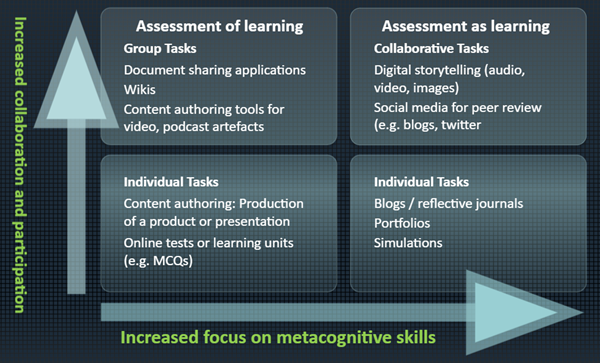Digital assessment and feedback
Online tests
Formative online quizzes created using the VLE test tool can allow students to self-check their knowledge and can provide teaching staff with diagnostic information to support teaching.
The test tool can be used to create quizzes or other forms of question-answer task, providing students the opportunity to:
- Check their memorisation of key facts
- Test their understanding of concepts
- Apply new knowledge to case studies and problems (supported by a range of question types)
- Complete mathematical problems (with the calculated numeric and calculated formula question type)
- Practice writing within a structured framework (with the essay question type).
These can allow students to self-check their knowledge and can provide teaching staff with diagnostic information to to support teaching.
Feedback can be provided automatically on a per-question basis. For correct/incorrect questions such as multiple-choice questions, you can provide two pieces of feedback: one if the student gets the answer right, another if the student gets the answer wrong. For questions such as essay questions, you can provide feedback text or model answers allowing student to compare their response to the model. Feedback can take one or more of the following forms:
- Simple correct/incorrect indicator
- Explanation of why an answer was correct/incorrect. This can help a student understand the reasoning behind the answer, and this can be equally important for correct answers as it is for incorrect ones
- Direction to resources and readings which provide the correct answer
- Suggestions for further reading.
It is worth bearing in mind the purpose of any formative task and choosing the form of feedback that would enable a student to take what they have learnt into subsequent activities.
Tests can also be used for summative assessment but this requires discussion with the Digital Education Team. Please see the Ultra Test guide for information.
Conditional release
Release conditions can be added onto items in VLE sites to make additional access to content or learning tasks dependent upon individual students’ performance or participation. Conditions can for access can be set based upon:
- Individual or group identity
- Date and time
- Performance (access is granted based on marks given on quizzes or other gradable items such as discussion boards or journals).
As an example, you could release model answers after a student submits a short essay (providing a mechanism to support students in understanding the differences between the model answer and their own work, such as a video talking through the model answer or face-to-face office hours).
You could also create a quiz providing students with an opportunity to check their own understanding of course materials and then release subsequent questions or materials according to the scores achieved.
This might provide an opportunity to provide some further support or practice for students who may be struggling with material and/or provide more stretching materials or suggestions for follow up reading or tasks as needed.
Please see the Content availability guide for information.
Multimedia production projects
Extending the range of assessment products can provide opportunities for students to develop ‘real-world’ skills and utilise different strengths beyond traditional text-based assessments.
This can include design of web sites, blogs, audio/video materials, and animations.
These approaches can provide options for students to select the format and approach they wish to take to meet the module learning outcomes increasing inclusivity and control, and allowing for a range of strengths to be emphasised.
Such activities can be incorporated into assessed group work projects further extending skills development and opportunities to align assessments with ongoing learning activities.
Practice-based assessments
Practice-based assessments such as performance, observations of teaching or other practices, and lab examinations can be supported through recording to allow ease of marking and moderation, and to support review and reflection. Digital methods can also allow for practices to be ‘captured’ for assessment in authentic settings.
Reflective journals, lab reports and professional practice records can allow for assessment of activities carried out over a period of time and thus for a focus on process as well as end product. Such methods can be usefully combined with other assessment activities to encourage assessment as learning, increase metacognitive skills and encourage students to take ownership of learning and make connections between different elements of learning activity. In the Departments of Law, Education and Nursing for example, students are encouraged to develop e-portfolios for assessment, recording and reflecting on experiences to map their learning and achievement to learning outcomes.
Digital feedback
A key goal of learning design is to ensure that students are provided with multiple forms of feedback as an integrated part of the learning process. In relation to staff feedback on assessments, digital methods can help to ensure that feedback is ‘useful, adequate, fair and timely’ (Guide to Assessment, 15.1.3) and that it can be clearly related to learning outcomes and criteria. Methods such as use of rubrics to clearly connect assessment to criteria, in-line text annotation and use of reusable comment banks, and audio and video feedback production have been used to increase the efficiency and richness of feedback.
The building in feedback page also provides suggestions for incorporating feedback into ongoing learning activities.

